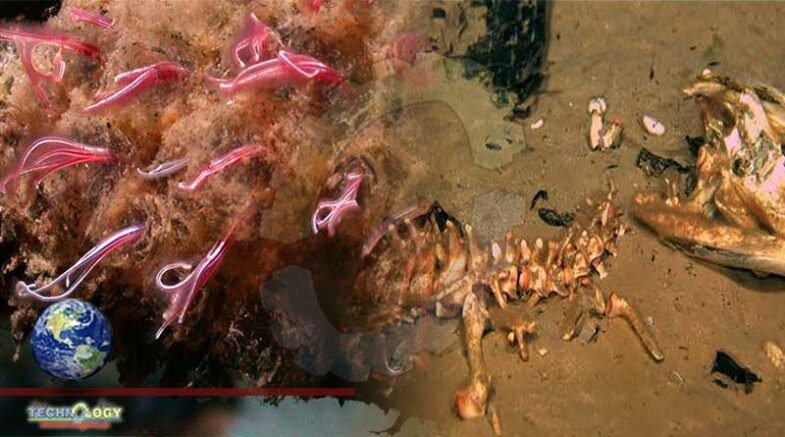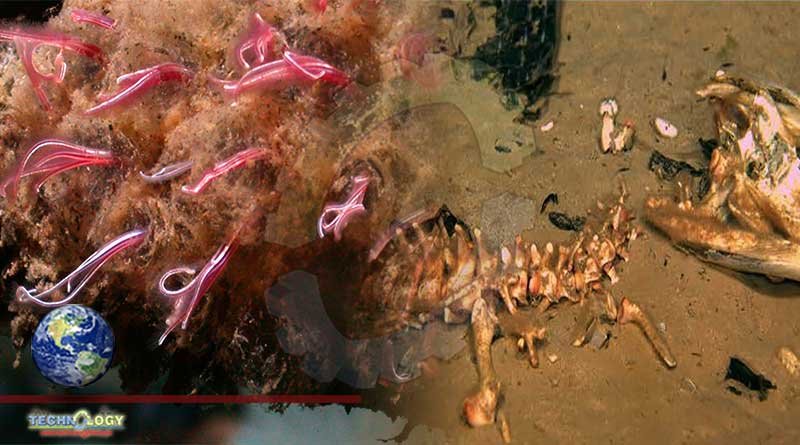The discovery of the strange new species, now known as “boneworms” has helped ignite the novel field of “curiosity-driven research,”

A mile below the ocean surface, scientists in 2002 encountered a fascinating sea creature clinging to a whale carcass at the bottom of the cold, dark Monterey Canyon: a living shag carpet.
The discovery of the strange new species, now known as “boneworms” or “zombie worms,” has helped ignite the novel field of “curiosity-driven research,” leading to the discovery of more than two dozen of the species’ close cousins, all behaving in ways never before known to science.
The original expedition, conducted by a research team at the Monterey Bay Aquarium Research Institute in Moss Landing, was designed to study methane gas bubbling up in Monterey Canyon.
That’s when scientists spotted the exposed bone surface of the giant whale corpse, covered by tiny living fibers. Seemingly attached to the whale’s bone, they created a sweeping, sanguine meadow atop the rotting cadaver.
“Everyone in the control room’s jumping up and down and doesn’t know what it is,” recalled Shana Goffredi, a MBARI adjunct who was one of the researchers on the expedition.
The fibers turned out to be a little marine worm in the genus now known as Osedax, a word that means “bone-eating” in Latin. The discovery was a pivotal point for the MBARI research group, inspiring a shift in the team’s investigative course from methane seeps to the bone-hungry worms.
The weird worms had (surprise!) weird eating habits, the scientists soon learned.
The team wanted to learn more. The first question on the scientists’ minds: Will Osedax eat any bones, or do they prefer whales? To find out, they built PVC trees with bones of different species dangling from strings. They hoped the boneworms would latch on to the bones and colonize them.
“It was kind of a little Blair Witch Project,” Goffredi said with a laugh, referring to the supernatural horror film released two years before she helped discover the zombie worms.
The researchers discovered that boneworms aren’t picky. If it’s a bone, they’ll eat it.
They had no digestive systems and no mouths and thus had no capacity to digest bones themselves. Instead, they had green roots that burrowed into the bones — which held populations of bacteria that seemed to live harmoniously with the worms.
Later analysis revealed the bacteria was responsible for breaking down the collagen in the bone and somehow delivering nutrients to the worms.
And while bone is particularly difficult to break down into usable molecules, Osedax has found a way. Because of the worms’ ability to process collagen in bones, they can drastically speed up the decomposition process, fast-tracking the delivery of nutrients from the corpse to its environment.
“Osedax is a game-changer when it comes to recycling wet bones in the wild into carbon,” said Greg Rouse, a marine biologist at the Scripps Institution of Oceanography in La Jolla.
Since the discovery nearly two decades years ago, scientists around the world have identified 32 different types of Osedax, all with the same signature red top. They’ve also found that boneworms harbor biological complexities that go beyond their eating habits.
Their sex, for instance, depends on where fertilized eggs land. If the egg settles on a bone, it becomes a female boneworm responsible for burrowing and feeding off the bone. If the egg lands on a female boneworm, however, it becomes a male — destined to hook onto a female and exist as a “sperm packet” for procreation.
The females are thousands of times larger than the males. Their bodies, including their ovaries, are located within a clear, mucousy tube inside of the bone. “I was looking at one of these tubes and saw these little tiny little ellipses against her body,” Rouse said, recalling his discovery of the male boneworms.
A single female can be the home for hundreds of tiny males ready to fertilize her eggs as they’re released.
Though they weren’t discovered until the early part of the 21st century, boneworms are actually quite ancient. One research team at the University of Plymouth in England recently uncovered Osedax borings on ancient marine reptile bones, indicating that boneworms existed as far back as 30 million years before mammals inhabited the oceans.
Why do they matter?
For now, they don’t have any economic or practical value. But the discovery of Osedax, scientists say, reminds us of how much of the ocean remains to be discovered and illustrates the value of curiosity-driven research.
Because of the boneworms’ unique biological features, many of the processes behind their mystique are yet to be understood. Researchers still don’t understand why Osedax roots are green or how collagen enters the roots.
But public funding of curiosity-driven research has dwindled in recent years. And to make matters worse, many of the experiments that are needed to fully understand the biology of boneworms are expensive, so funding is becoming more and more difficult to come by. To fund curiosity-driven research, institutes such as MBARI now primarily rely on limited private funding from sources like the David and Lucile Packard Foundation and the Schmidt Family Foundation.
Shannon Johnson, a senior research technician at MBARI who was part of the original expedition, is adamant about the value of discovery without the expectation of human applications.
In a world where species are dying off at an alarming rate — “hundreds, or even thousands, of times higher than the natural baseline rate,” according to the Smithsonian’s National Museum of Natural History — the discovery of a fascinating new organism is a welcome surprise. But without money for open-ended expeditions, she said, discoveries of organisms like Osedax would not be possible.
“It’s so important to be able to have that flexibility and be able to discover things,” Johnson said. “We are in this age of mass extinctions and we have barely begun to scratch the surface of what is in the ocean.”
Originally published at Monterey Herald
